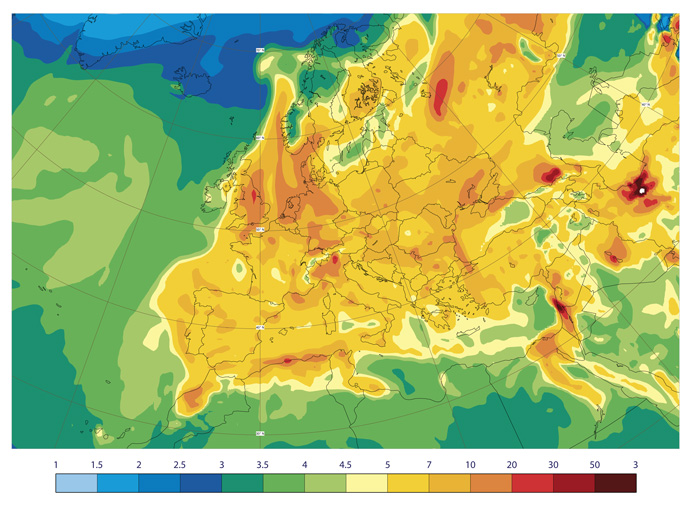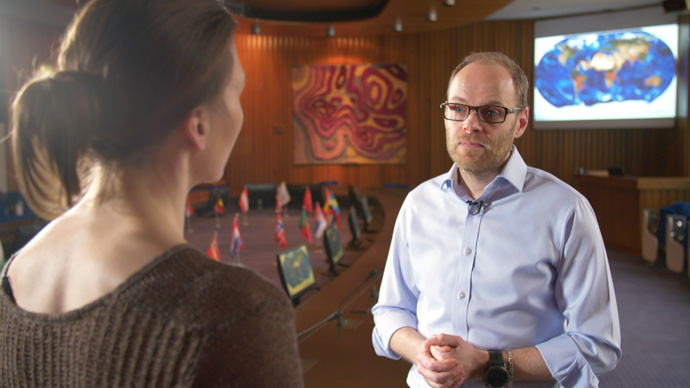
Mark Parrington, Senior Scientist, Copernicus Atmosphere Monitoring Service
The Copernicus Atmosphere Monitoring Service (CAMS), implemented by ECMWF on behalf of the European Commission, has teamed up with EUMETSAT to produce a Massive Open Online Course (MOOC) on “Monitoring Atmospheric Composition” through Future Learn.
MOOCs provide easy to understand videos and articles for a public audience and they allow for interaction between learners and the course educators. The course launched on 5 November with more than 2000 people taking part from countries all around the world.
In my role as one of the lead educators (along with Rosemary Munro from EUMETSAT), I have been involved in the planning, filming, and now the running of the MOOC. This has been an interesting process and very different from my scientific work in CAMS on wildfire emissions and inventories of global emissions from natural and anthropogenic sources. During my career I have been fortunate to have worked on several aspects of atmospheric composition including satellite observations, in situ measurements, modelling atmospheric chemistry and transport, and assimilating atmospheric composition data, and it has been satisfying to work on a project which brings everything together in one place.
CAMS – providing free and open access information on air quality
The quality of the air we breathe affects every aspect of our lives and can have serious impacts on our health and the environment. CAMS provides free, open access data about air quality at both global and regional (European) scales. The monitoring and forecasting service provided by CAMS is vital for understanding changes in air quality, managing our lives and informing policy decisions.

An example of the air quality information provided by CAMS. This plot shows total column nitrogen dioxide over Europe. Units 1015 molecules per cm2. A wide range of CAMS products are available.
An important aspect of CAMS is to provide complex information in an easily understandable way to users. Simple metrics, such as air quality indices, can be used in apps and weather reports to indicate relative levels of local air pollution. However, information about the details of the measurements, and modelling involved in calculating them, is more challenging to convey to users. So, the MOOC is helping us to provide accessible information on the complexity required for running an operational atmospheric monitoring service like CAMS. Once the initial 5 week course is over, the material will remain as an online resource for people to learn about all aspects of monitoring atmospheric composition and air quality.
Developing the MOOC
The MOOC was developed by Imperative Space and is presented by physicist and BBC broadcaster Helen Czerski of University College London. A wide range of the inputs required for monitoring atmospheric composition is covered in the MOOC through interviews with numerous experts, complemented by supplementary materials and links to online resources. The inputs have a high level of complexity in themselves and Imperative Space have done an excellent job in making this information very concise and understandable to a non-expert user through the conversational nature of the interviews.
As well as myself as lead educator, several other ECMWF staff were interviewed.
The MOOC is running for 5 weeks and each week presents a different theme:
- Our fragile atmosphere and the challenges we face;
- Pollution, air quality and health;
- Large scale changes – ozone and GHGs;
- Long range pollution transport; and
- Maintaining our life support system – policy and future.

Mark Parrington being interviewed by Helen Czerski for one of the videos featured in the MOOC. (Image: Imperative Space)
Participants are able to interact directly on each element of the content with comments or questions, the most interesting of which will be addressed in a live weekly video round-up via Facebook Live.
Showcasing ECMWF and CAMS through the MOOC
For ECMWF and CAMS, the MOOC is an excellent opportunity to showcase the work that we do. Very few centres around the world have the facilities and infrastructure to provide near-real-time information on global atmospheric composition. This puts us in a very unique position to show the world what is possible for monitoring air quality with all the information sources that are available.
The free and open access data policy of CAMS means that we can provide the most up-to-date and state-of-the-art information on air quality directly to global citizens. In this respect, our hopes for the MOOC are to show people this and also give them some of the technical background to everything that goes into CAMS, in the most accessible and easy to understand way possible.
The level of interest we have had in the MOOC shows that there is a great deal of interest in air quality and the tools available for monitoring and improving the general understanding of an ever growing issue in the public mind.
Top banner image credit: EUMETSAT
